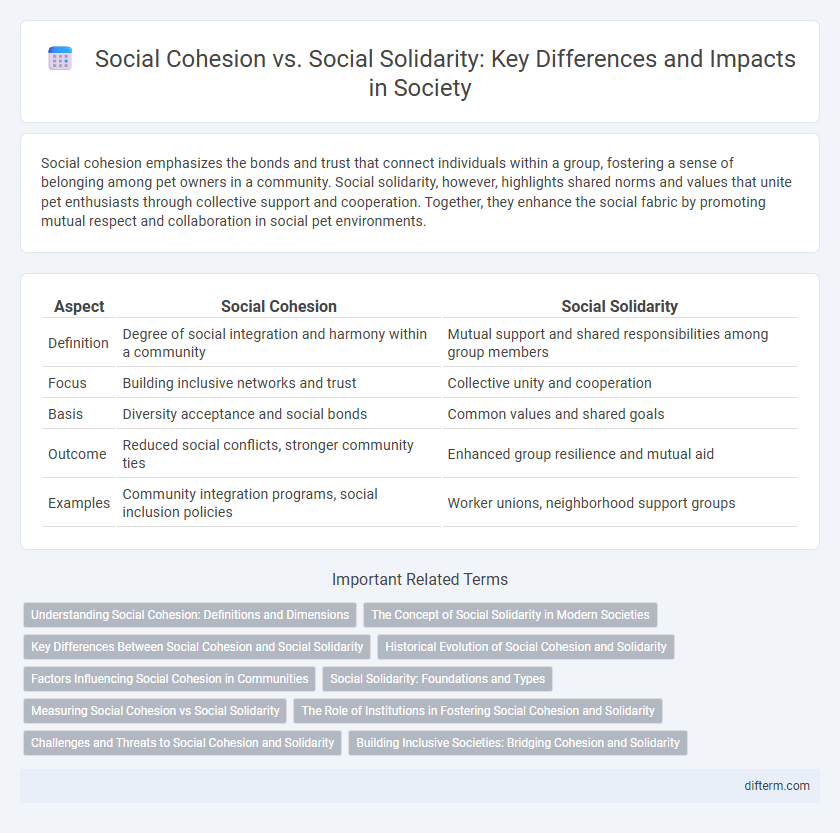Social cohesion emphasizes the bonds and trust that connect individuals within a group, fostering a sense of belonging among pet owners in a community. Social solidarity, however, highlights shared norms and values that unite pet enthusiasts through collective support and cooperation. Together, they enhance the social fabric by promoting mutual respect and collaboration in social pet environments.
Table of Comparison
| Aspect | Social Cohesion | Social Solidarity |
|---|---|---|
| Definition | Degree of social integration and harmony within a community | Mutual support and shared responsibilities among group members |
| Focus | Building inclusive networks and trust | Collective unity and cooperation |
| Basis | Diversity acceptance and social bonds | Common values and shared goals |
| Outcome | Reduced social conflicts, stronger community ties | Enhanced group resilience and mutual aid |
| Examples | Community integration programs, social inclusion policies | Worker unions, neighborhood support groups |
Understanding Social Cohesion: Definitions and Dimensions
Social cohesion refers to the strength of relationships and the sense of belonging within a community, encompassing dimensions such as social inclusion, trust, and participation. Social solidarity emphasizes the shared values and collective responsibility that bind individuals together, highlighting common identity and mutual support. Understanding these concepts involves analyzing how social networks, cultural norms, and institutional frameworks contribute to a unified and cooperative society.
The Concept of Social Solidarity in Modern Societies
Social solidarity in modern societies emphasizes the interdependence and shared values that bind individuals beyond mere social cohesion. It fosters a collective conscience, promoting cooperation and mutual support within diverse populations. This concept strengthens societal resilience by encouraging active participation and a sense of belonging among community members.
Key Differences Between Social Cohesion and Social Solidarity
Social cohesion emphasizes the strength of relationships and the sense of belonging within a community, fostering trust and cooperation among diverse groups. Social solidarity highlights the shared values, norms, and mutual obligations that bind members of a society, often rooted in collective identity and common goals. Key differences lie in cohesion's focus on social bonds and integration, while solidarity centers on unity through shared purpose and moral commitments.
Historical Evolution of Social Cohesion and Solidarity
Social cohesion and social solidarity have evolved through distinct historical phases, reflecting shifts in societal structures from agrarian communities to industrialized nations. Emile Durkheim's seminal work highlighted how mechanical solidarity dominated pre-industrial societies, fostering cohesion through shared beliefs and homogeneity, while organic solidarity emerged in modern societies, emphasizing interdependence and cooperation within diverse populations. Contemporary social cohesion integrates these concepts, focusing on social inclusion, trust, and collective identity as key components for stable and resilient communities.
Factors Influencing Social Cohesion in Communities
Factors influencing social cohesion in communities include shared values, trust among community members, and effective communication channels that foster inclusion. Economic stability and equitable access to resources also play critical roles in promoting mutual support and reducing social conflicts. Strong social networks and participatory governance further enhance collective identity and cooperation within diverse groups.
Social Solidarity: Foundations and Types
Social solidarity forms the foundation of collective unity by fostering shared values, mutual support, and a sense of belonging within communities. Emile Durkheim identified two primary types: mechanical solidarity, characterized by homogeneity and strong interpersonal ties in traditional societies, and organic solidarity, emerging from interdependence and specialization in modern, complex societies. These forms of social solidarity are essential for maintaining social order and reinforcing communal bonds amidst diversity.
Measuring Social Cohesion vs Social Solidarity
Measuring social cohesion involves assessing the strength of relationships and the sense of belonging among members of a community through indicators like trust, shared values, and participation in social networks. Social solidarity measurement focuses on the extent of mutual support, collective responsibility, and cooperation within groups, often evaluated using social capital metrics and community engagement levels. Quantitative data from surveys and qualitative analyses of social behaviors provide complementary insights to differentiate these concepts effectively.
The Role of Institutions in Fostering Social Cohesion and Solidarity
Institutions such as governments, educational systems, and community organizations play a critical role in fostering social cohesion by promoting inclusive policies, equitable resource distribution, and collective identity. Social solidarity is strengthened through institutional frameworks that encourage cooperation, mutual support, and shared values among diverse groups. Effective institutional interventions reduce social fragmentation and build trust, creating a stable foundation for cohesive and resilient societies.
Challenges and Threats to Social Cohesion and Solidarity
Challenges to social cohesion and solidarity arise from economic inequality, cultural fragmentation, and political polarization, which erode trust and mutual support within communities. Threats such as misinformation, social exclusion, and identity conflicts exacerbate divisions, undermining collective action and shared identity. Addressing these issues requires targeted policies that promote inclusive dialogue, equitable resource distribution, and social integration initiatives.
Building Inclusive Societies: Bridging Cohesion and Solidarity
Building inclusive societies hinges on integrating social cohesion, which emphasizes connectedness and shared values, with social solidarity, rooted in mutual support and collective responsibility. Strengthening community ties requires policies fostering equal participation, trust, and recognition of diversity to ensure all members feel valued. Effective social frameworks promote both cohesion and solidarity, enabling resilient, harmonious societies that thrive on inclusivity and cooperation.
social cohesion vs social solidarity Infographic

 difterm.com
difterm.com